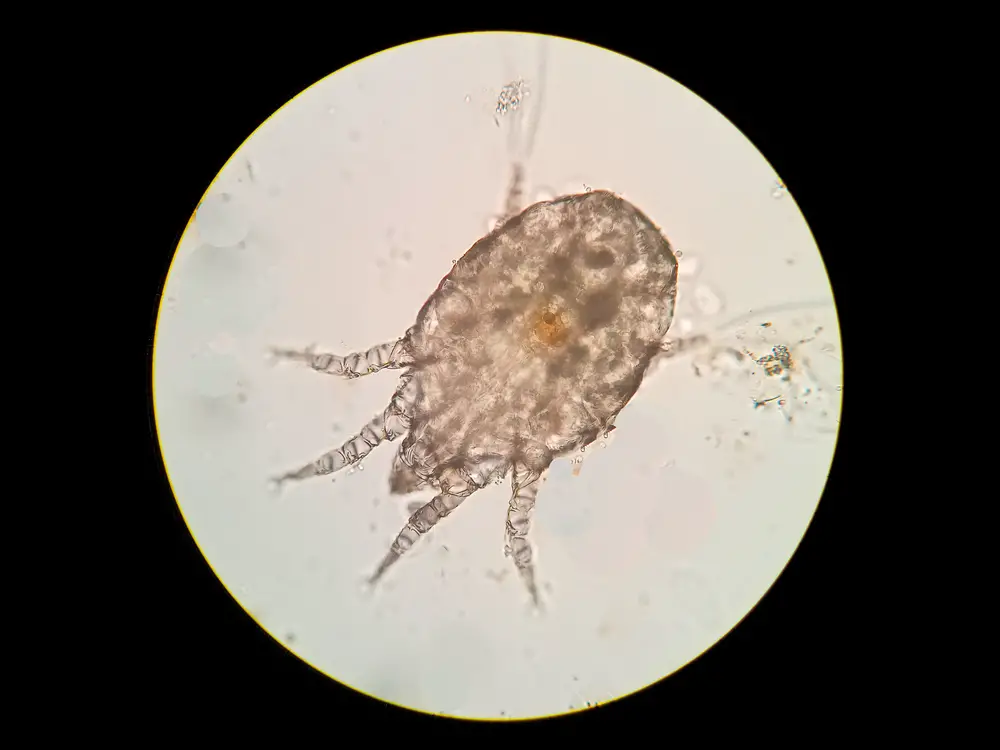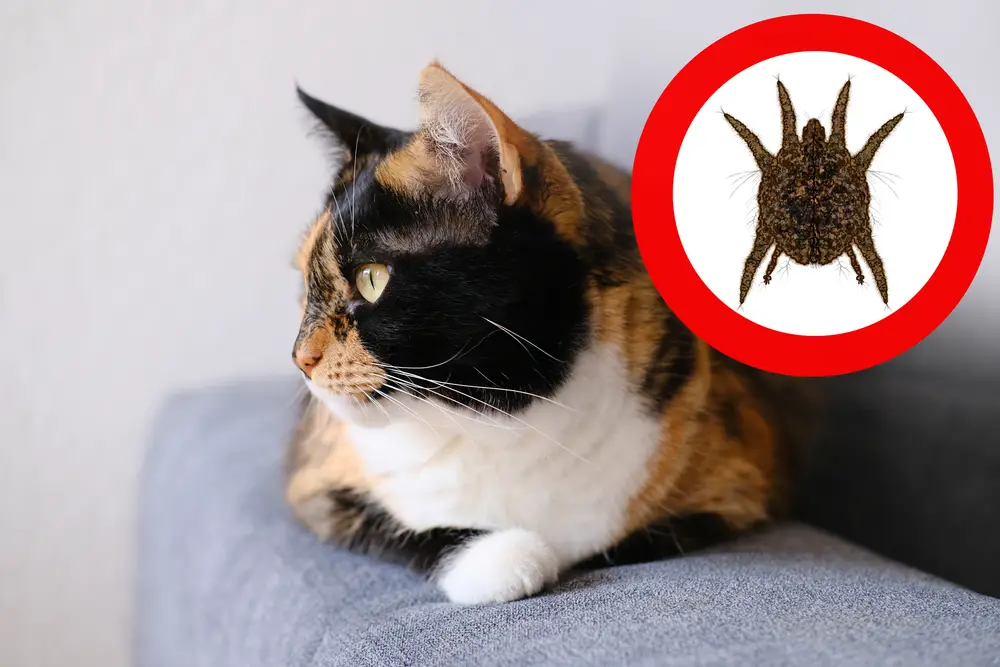Ear mites are tiny parasites that live in the ears of animals, causing irritation and discomfort. Baking soda can be an effective and affordable way to eliminate these pests.
While baking soda can be an effective treatment for ear mites, it is important to note that it should not be used as a substitute for veterinary care.
Quick Answer:
Baking soda may offer some relief from ear mites due to its drying and alkaline properties, which can create a less hospitable environment for the mites. However, it’s not a scientifically proven treatment.
If your pet is showing signs of an ear mite infestation, it is important to take them to a veterinarian for proper diagnosis and treatment. Baking soda can be used as a complementary treatment but should not be relied on as the sole solution.
Understanding Ear Mites

Ear mites are tiny parasites that infest the ears of animals, including cats and dogs. These mites, also known as otodectes cynotis, can cause irritation, inflammation, and infection in the ear canal.
They are highly contagious and can spread from one animal to another through direct contact.
The ear mite is a type of arachnid similar to ticks and spiders. It is a microscopic creature that feeds on the skin cells and wax in the ear canal. The female mite lays eggs in the ear canal, which hatch into larvae and then mature into adult mites.
The entire life cycle of the mite takes place in the ear canal, where it causes irritation and inflammation.
Ear mites are commonly found in cats, but they can also infest dogs and other animals. They are highly contagious and can spread from one animal to another through direct contact.
Bird mites can also infest the ears of animals, causing similar symptoms.
Symptoms of ear mite infection include itching, head shaking, ear scratching, and discharge from the ear. If left untreated, ear mite infestation can lead to more serious infections, including bacterial and fungal infections.
Treatment for ear mites typically involves cleaning the ear canal and administering medication to kill the mites. Baking soda is a natural remedy that can be used to kill ear mites.
It works by changing the pH of the ear canal, making it less hospitable to the mites. Baking soda is also effective at reducing inflammation and soothing irritation in the ear canal.
Symptoms of Ear Mites
Ear mites are tiny parasites that can cause a variety of symptoms in both dogs and humans. These symptoms can range from mild irritation to serious infections if left untreated.
Some of the most common symptoms of ear mites include:
- Scratching and itching at the ears
- Redness and irritation in the ear canal
- Discharge or a buildup of ear wax
- Hearing loss or a decreased ability to hear
- Itching around the head and neck area
In dogs, ear mites can also cause a distinctive odor and a dark, coffee-ground-like substance in the ear canal. If left untreated, ear mites can lead to more serious infections, such as bacterial or yeast infections.
In humans, ear mites can cause intense itching and a feeling of fullness in the ear. They can also lead to infections if the skin in the ear canal becomes irritated and cracked from scratching.
If you suspect that you or your pet may have ear mites, it is important to seek treatment as soon as possible to prevent further complications. A veterinarian or doctor can diagnose ear mites by examining the ear canal and taking a sample of ear wax for testing.
Diagnosis and Treatment
Ear mites can be diagnosed by a veterinarian through a physical examination of the ear canal and skin. The veterinarian may take a sample of the ear discharge to confirm the presence of ear mites under a microscope.
Once diagnosed, treatment should begin immediately to prevent the spread of the mites to other pets or humans. The veterinarian may prescribe medication such as neomycin, selamectin, ivermectin, or permethrin to kill the ear mites.
Baking soda can also be used as a home remedy to kill ear mites. A mixture of baking soda and water can be applied to the ear canal using a dropper. The mixture should be left in the ear for several minutes before being wiped away with a cotton ball.
It is important to note that while baking soda may be effective in killing ear mites, it should not be used as a substitute for veterinary care. A veterinarian can provide proper diagnosis and prescribe appropriate medication to fully treat the ear mites.
How Baking Soda Works

Baking soda is a common household ingredient that has been used for various purposes, including cleaning, deodorizing, and cooking. When it comes to ear mites, baking soda can be an effective remedy due to its alkaline nature.
Ear mites are tiny parasites that live in the ear canal of animals, including cats and dogs. They feed on the earwax and oils in the ear canal, causing irritation, inflammation, and infection.
Baking soda works by changing the pH level of the ear canal, making it less hospitable for the mites to survive.
To use baking soda for ear mites, it can be mixed with water to make a mild solution. The solution can be used to clean the ear canal, removing the earwax and debris that the mites feed on.
A cotton ball can be soaked in the solution and used to gently wipe the inside of the ear.
Baking soda can also be used as a spray to kill the mites directly. A solution of baking soda and water can be mixed and sprayed into the ear canal. The solution should be left in the ear for a few minutes before being wiped away with a cotton ball.
In addition to killing the mites, baking soda can also help to soothe the irritation and inflammation caused by the infestation. It can help to reduce itching and redness, making the animal more comfortable.
Alternative Remedies
In addition to using baking soda to kill ear mites, there are other alternative remedies that may be effective.
Some of these remedies include:
Apple Cider Vinegar
Apple cider vinegar has antibacterial and antifungal properties that may help to eliminate ear mites. To use apple cider vinegar as a remedy, mix equal parts of water and apple cider vinegar and apply a few drops into the ear canal.
Gently massage the ear to ensure the solution reaches all areas of the ear. Repeat this process twice a day for a week.
Borax
Borax is a natural mineral that can be used to kill ear mites. Mix a small amount of borax with warm water and apply a few drops into the ear canal. Massage the ear to ensure the solution reaches all areas of the ear. Repeat this process twice a day for a week.
Mineral Oil
Mineral oil can be used to suffocate ear mites. Apply a few drops of mineral oil into the ear canal and massage the ear to ensure the oil reaches all areas of the ear. Repeat this process twice a day for a week.
Saline Solution
Saline solution can be used to flush out ear mites. Mix equal parts of warm water and salt and apply a few drops into the ear canal. Gently massage the ear to ensure the solution reaches all areas of the ear. Repeat this process twice a day for a week.
Triamcinolone Acetonide
Triamcinolone acetonide is a steroid that can be used to reduce inflammation caused by ear mites. Apply a small amount of triamcinolone acetonide into the ear canal and massage the ear to ensure the solution reaches all areas of the ear. Repeat this process twice a day for a week.
Olive Oil
Olive oil can be used to suffocate ear mites. Apply a few drops of olive oil into the ear canal and massage the ear to ensure the oil reaches all areas of the ear. Repeat this process twice a day for a week.
Hydrogen Peroxide
Hydrogen peroxide can be used to flush out ear mites. Mix equal parts of hydrogen peroxide and water and apply a few drops into the ear canal. Gently massage the ear to ensure the solution reaches all areas of the ear. Repeat this process twice a day for a week.
Essential Oils
Some essential oils, such as tea tree oil and eucalyptus oil, have antibacterial and antifungal properties that may help to eliminate ear mites. Mix a few drops of essential oil with a carrier oil, such as olive oil or coconut oil, and apply a few drops into the ear canal.
Gently massage the ear to ensure the solution reaches all areas of the ear. Repeat this process twice a day for a week.
Preventive Measures
Preventing ear mites is the best way to avoid the need for treatment.
Here are some preventive measures that can help keep ear mites at bay:
- Clean the ears regularly: Regular cleaning of the ears can help remove any dirt or debris that may attract ear mites. Use a gentle, non-irritating ear cleaner to clean the ears.
- Vacuum regularly: Vacuuming the house regularly can help remove any ear mites or eggs that may be present in the environment. Pay special attention to areas where pets spend most of their time, such as beds and couches.
- Wash bedding and other fabrics: Wash bedding, blankets, and other fabrics that come in contact with pets regularly in hot water to kill any mites or eggs that may be present.
- Reduce humidity: Ear mites thrive in humid environments, so reducing the humidity in the home can help prevent their growth. Use a dehumidifier or air conditioner to keep the air dry.
- Use insecticide: Insecticides can be used to kill ear mites in the environment. Use an insecticide that is safe for pets and follow the instructions carefully.
- Avoid exposure to allergens: Allergens can weaken the immune system and make pets more susceptible to ear mites. Avoid exposing pets to allergens such as dust, pollen, and mold.
- Keep pets away from other animals: Ear mites can be easily spread from one animal to another. Keep pets away from other animals that may be infected with ear mites.
- Use a filter in the vacuum cleaner: Using a filter in the vacuum cleaner can help trap any mites or eggs that may be present in the environment.
- Avoid using soapy water: Soapy water can be irritating to the ears and may cause more harm than good. Use a gentle, non-irritating ear cleaner instead.
- Maintain a clean environment: Keeping the environment clean and free of dirt and debris can help prevent the growth of ear mites.
- Provide a comfortable sleeping area: Providing pets with a comfortable sleeping area can help reduce stress and strengthen the immune system, making them less susceptible to ear mites. Use a mattress that is easy to clean and maintain.
Ear Mites and Humans
Ear mites are tiny parasites that infest the ears of animals, including dogs, cats, rabbits, and ferrets. However, they can also infect humans, particularly those who have close contact with infected animals. Ear mites in humans are rare but can cause itching and discomfort in the ears.
Ear mites do not live on human hair follicles like Demodex mites, which are commonly found on the cheeks and other areas of the face. They are not contagious between humans but can be transmitted from infected animals.
Humans with weakened immune systems or sensitive skin may be more susceptible to ear mite infestations.
The symptoms of ear mites in humans include itching, redness, and inflammation in the ear canal. In severe cases, the infestation can lead to dermatitis and hair loss around the ears. If you suspect an ear mite infestation, it is important to seek medical attention from a dermatologist.
Treatment for ear mites in humans typically involves applying a topical cream or lotion containing crotamiton to the affected area. This medication helps to kill the mites and relieve symptoms.
In more severe cases, oral medications or antibiotics may be necessary to treat secondary infections caused by scratching and irritation.
Overall, while ear mites in humans are rare, they can cause discomfort and require prompt treatment to prevent complications.
Ear Mites in Other Animals
Ear mites are not only a problem in dogs but also in other animals such as cats, rabbits, and ferrets. In cats, ear mites are one of the most common causes of ear infections. Bird mites can also cause infestations in birds, and spider mites can cause damage to plants.
Ear mites can be transmitted from one animal to another through direct contact or through contact with contaminated objects. In addition to causing discomfort and irritation, ear mites can also lead to secondary infections and hearing loss if left untreated.
Regular cleaning of the ears can help prevent ear mite infestations. This includes removing any debris or wax buildup and using a gentle ear cleaner to keep the ears clean and dry. Massaging the base of the ear can also help to loosen any debris and promote circulation.
Baking soda has been suggested as a natural remedy for ear mites in some animals.
However, there is limited scientific evidence to support its effectiveness. It is important to consult with a veterinarian before using any home remedies for ear mites, as some may be harmful or ineffective.


